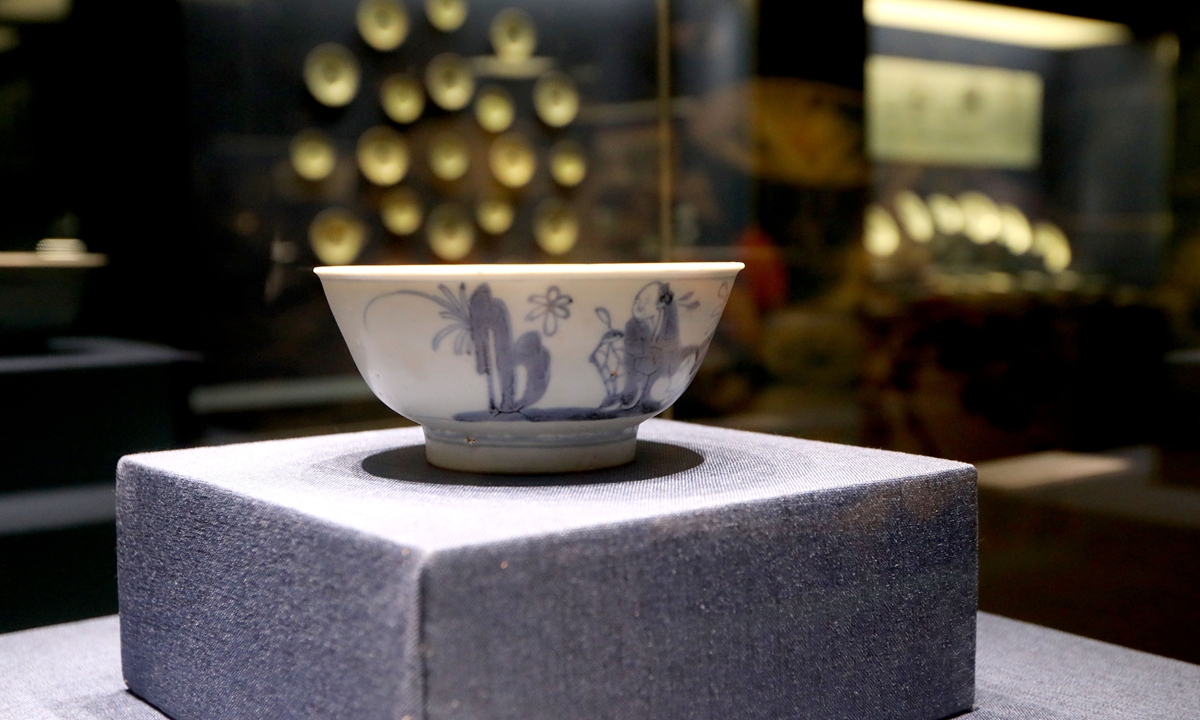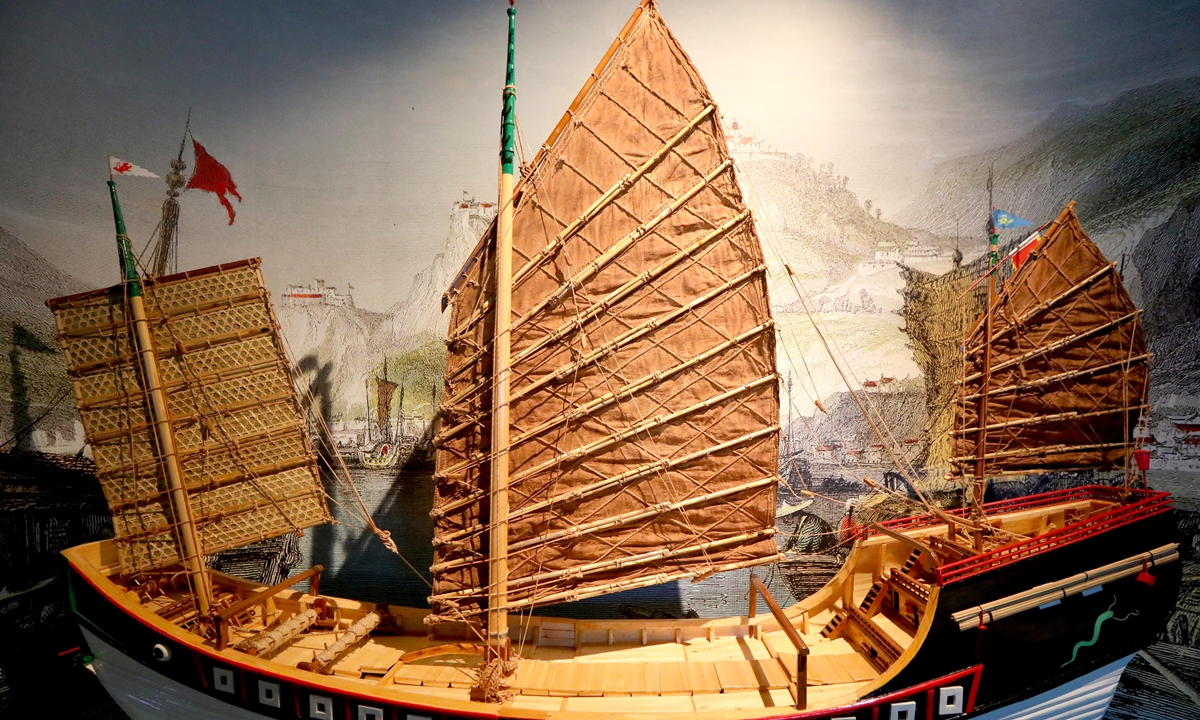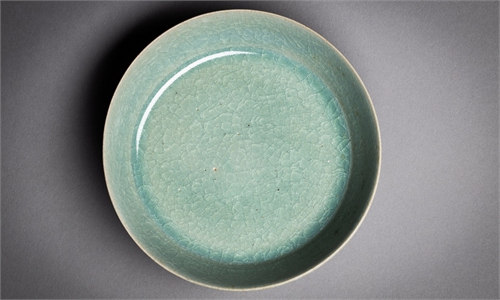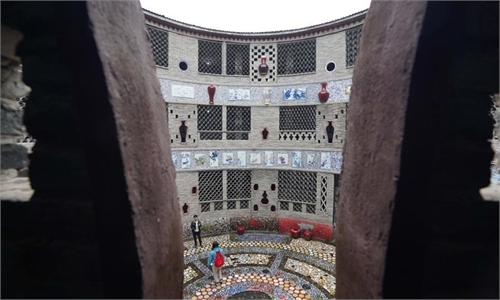ARTS / ART
China Maritime Museum kicks off exhibition on largest Chinese wooden shipwreck
Titanic of the East

A blue and white porcelain bowl Photo: Chen Xia/GT

A model of the Tek Sing merchant ship Photo: Chen Xia/GT
An exhibition about the Tek Sing shipwreck, the wreckage of a Chinese merchant ship that sank off the coast of Indonesia during the Qing Dynasty (1644-1911), kicked off on Tuesday at the China Maritime Museum in Shanghai. The ship is often called the "Titanic of the East" because it is the largest Chinese wooden sailing ship ever discovered in the history of marine archeology and due to the large number of intact relics discovered at the site.
The four-part exhibition covers the doomed voyage of the Tek Sing 200 years ago, how it was discovered and salvaged by foreign rescue teams, the efforts of Chinese businessmen to return the relics recovered from the wreck to China through auctions and buy-back programs, and current research into the shipwreck itself.
As the first large-scale exhibition about the Tek Sing shipwreck in China, the exhibition displays more than 400 porcelain wares, including white glaze, blue-and-white and greenish-brown glaze bowls, cups, plates and vases.
As the porcelain pieces from the wreckage were all produced at the famous Dehua kilns in East China's Fujian Province, the exhibition also delves into the 1,000-year history of the kiln, which mainly produced wares for export.
Past and present
When speaking about the unique nature of the shipwreck, Mao Min, director of the museum's Display Department, told the Global Times on Tuesday that the Tek Sing is the largest Chinese wooden sailing ship ever discovered in the history of maritime archeology and contained the largest number of relics ever recovered from a shipwreck.
"Sadly, it is also the shipwreck with the largest number of victims when it comes to ancient wooden sailing ships," he noted.
"Wooden sailing ships like the Tek Sing were the last witnesses of, as well as a miniaturized example of China's ancient Maritime Silk Road. The Tek Sing shipwreck also gives us an opportunity to see the charm of ancient Chinese wooden seagoing ships," Mao said.
Mao added that news concerning the sinking of the Tek Sing was recorded in some foreign newspapers such as the Calcutta Gazette and overseas books at the time, allowing people today to gain further insight into the ship's history.
The Tek Sing, 50 meters long and 10 meters wide, set off from the Port of Xiamen in January 1822, but unfortunately sank after it hit a large rock near Indonesia.
According to estimates, around 1,600 passengers and crew went down with the ship to remain on the bottom of the sea forever.
According to a report from Chinese media outlet The Paper, a book written by James Horsburgh, an employee of the British East India Company, in 1843 also recorded some information about the shipwreck, saying that 140 people were saved from sinking ship, while the 1,600 victims aged from 6 to 70 years old.
In May 1999, the Tek Sing shipwreck was discovered by shipwreck explorer Mike Hatcher. Later salvage operations raised about 350,000 pieces of porcelain wares from the wreck.
Some mysteries continue to surround the ship including what caused its captain to suddenly change course from his original planned route.
Return from overseas
The sheer number of relics discovered at the Tek Sing shipwreck shocked the world and were later scattered all around the world, often appearing at large-scale auctions. For instance, Germany's Nagel auction house auctioned Tek Sing porcelain in 2000.
In 2018, Chinese businessman Zheng Changlai purchased 120,000 relics from a British company and sent these cultural relics back to the motherland.
In 2020, Zheng donated the relics to the museum, paving the way for the exhibition about the shipwreck to become a reality.
One of the visitors at the exhibition on Tuesday told the Global Times that seeing all these porcelains gathered together felt "great."
"I can imagine the scene of thousands of porcelain wares packed tightly and neatly on the ship as it set out to the sea. This exhibition brings me closer to history," the visitor said.
Most of the porcelain recovered from the wreck was produced in the Dehua kilns in Dehua, Fujian Province. Dehua was a major center for porcelain production, and more than 180 ancient kilns sites dating from the Song Dynasty (960-1279) to the Qing Dynasty have been discovered in the region to date.
Using the story of the shipwreck as a starting point, the exhibition also introduces the development of Dehua porcelain, which was so popular overseas that it was often copied by foreign porcelain makers.
White glaze porcelain was one of the most famous types of Dehua porcelain.
Large quantities of this porcelain arrived in Europe in the early 18th century and was also exported to Japan in large amount.
In 2021, the kilns of Dehua were inscribed on the UNESCO World Heritage List along with many other sites near Quanzhou, Fujian Province, for their import role in ancient maritime trade and the exchange of culture and ideas around the world.
The exhibition is set to run until January 2022.




